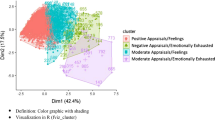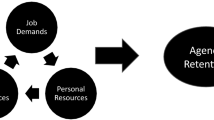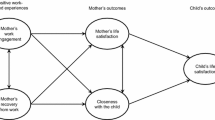Abstract
Background
As the demand for child care continues in the United States, the well-being of the child care workforce is an important consideration as well. Child care providers have job-related stresses, which affect their physical and mental health, ultimately can lead to a variety of concerns including, high turnover and overall quality of services.
Objectives
The purpose of the study is to examine the level of work engagement among child care workers. Specific attentions were paid to examine factors associated with work engagement using job demands–resources model.
Method
A cross-sectional design was used to analyze a total of 393 child care workers to examine the factors associated with their work engagement.
Results
Results of hierarchical linear regression analysis suggested that job resources, psychological rewards, and job control are significantly associated with child care workers’ work engagement. The study findings also confirm the buffering effect of job resources (perceived positive feelings about their job) on the relationship between job demands and work engagement. When there was low level of psychological rewards, there was a high negative relationship between job demands and work engagement; while when there was high level of psychological rewards, the job demands had no relationship with work engagement.
Conclusions
Overall, the findings show a link between having a high level of positive feelings and child care providers’ engagement at work. Developing strategies to reinforce employees’ positive feelings toward work may help to develop and maintain an engaged workforce. Studies testing such strategies are needed.
Similar content being viewed by others
References
Bakker, A. B. (2011). An evidence-based model of work engagement. Current Directions in Psychological Science, 20(4), 265–269.
Bakker, A. B., & Demerouti, E. (2007). The job demands–resource model: State of the art. Journal of Managerial Psychology, 22(3), 309–328.
Bakker, A. B., Demerouti, E., & Sanz-Vergel, A. I. (2014). Burnout and work engagement: The JD–R approach. Annual Review of Organizational Psychology and Organizational Behavior, 1(1), 389–411.
Bakker, A., Demerouti, E., & Schaufeli, W. (2003). Dual processes at work in a call centre: An application of the job demands–resources model. European Journal of Work and Organizational Psychology, 12(4), 393–417.
Bakker, A. B., Schaufeli, W. B., Leiter, M. P., & Taris, T. W. (2008). Work engagement: An emerging concept in occupational health psychology. Work & Stress, 22(3), 187–200.
Baumgartner, J. J., Carson, R. L., Apavaloaie, L., & Tsouloupas, C. (2009). Uncovering common stressful factors and coping strategies among childcare providers. Child & Youth Care Forum, 38(5), 239–251.
Blacksmith, N., & Harter, J. (2011). Majority of American workers not engaged in their jobs. Gallup Wellbeing. Retrieved July 30, 2017 from http://www.gallup.com/poll/150383/Majority-American-Workers-Not-Engaged-Jobs.aspx.
Chen, S. Y., & Scannapieco, M. (2010). The influence of job satisfaction on child welfare worker’s desire to stay: An examination of the interaction effect of self-efficacy and supportive supervision. Children and Youth Services Review, 32(4), 482–486.
Child Care Aware of America. (2017). Checking in: A snapshot of the child care landscape CCAoA’s annual state fact sheets. Retrieved May 1, 2018 from http://usa.childcareaware.org/wp-content/uploads/2017/07/FINAL_SFS_REPORT.pdf.
Christian, M. S., Garza, A. S., & Slaughter, J. E. (2011). Work engagement: A quantitative review and test of its relations with task and contextual performance. Personnel Psychology, 64(1), 89–136.
Cohen, J., Cohen, P., West, S. G., & Aiken, L. S. (2003). Applied multiple regression/correlation analysis for the behavioral sciences. New York: Psychology Press.
Crabtree, S. (2003). Bringing work problems home. Gallup Business Journal. Retrieved July 30, 2017 from http://businessjournal.gallup.com/content/1078/Bringing-Work-Problems-Home.aspx.
Curbow, B., Spratt, K., Ungaretti, A., McDonnell, K., & Breckler, S. (2000). Development of the child care worker job stress inventory. Early Childhood Research Quarterly, 15(4), 515–536.
Deery-Schmitt, D. M., & Todd, C. M. (1995). A conceptual model for studying turnover among family child care providers: A longitudinal study. Early Childhood Research Quarterly, 10(1), 121–143.
Demerouti, E., Bakker, A. B., Nachreiner, F., & Schaufeli, W. B. (2001). The job demands—Resources model of burnout. Journal of Applied Psychology, 86(3), 499–512.
Faulkner, M., Gerstenblatt, P., Lee, A., Vallejo, V., & Travis, D. (2016). Childcare providers: Work stress and personal well-being. Journal of Early Childhood Research, 14(3), 280–293.
Hakanen, J. J., Bakker, A. B., & Demerouti, E. (2005). How dentists cope with their job demands and stay engaged: The moderating role of job resources. European Journal of Oral Sciences, 113(6), 479–487.
Hakanen, J. J., Bakker, A. B., & Schaufeli, W. B. (2006). Burnout and work engagement among teachers. Journal of School Psychology, 43, 495–513.
Halbesleben, J. R. B. (2010). A meta-analysis of work engagement: Relationships with burnout, demands, resources, and consequences. In A. B. Bakker & M. P. Leiter (Eds.), Work engagement: A handbook of essential theory and research (pp. 102–117). New York, NY: Psychology Press.
Hamre, B. K., & Pianta, R. C. (2004). Self-reported depression in nonfamilial caregivers: Prevalence and associations with caregiver behavior in child-care settings. Early Childhood Research Quarterly, 19(2), 297–318.
Harter, J. K., & Agrawal, S. (2012). Engagement at work: Working hours, flextime, vacation time, and wellbeing. Gallup. Retrieved May 11, 2016 from http://www.gallup.com/strategicconsulting/157238/engagement-work-working-hours-flextime-vacation-time-wellbeing.aspx.
Harter, J. K., Schmidt, F. L., & Hayes, T. L. (2002). Business-unit-level relationship between employee satisfaction, employee engagement, and business outcomes: A meta-analysis. Journal of Applied Psychology, 87(2), 268–279.
Kline, R. B. (2005). Methodology in the social sciences. Principles and practice of structural equation modeling (2nd ed.). New York, NY: Guilford Press.
Laughlin, L. (2013). Who’s minding the kids? Child care arrangements: Spring 2011. Current Population Reports, P70-135. Washington, DC: U.S. Census Bureau.
Lewig, K. A., Xanthopoulou, D., Bakker, A. B., Dollard, M. F., & Metzer, J. C. (2007). Burnout and connectedness among Australian volunteers: A test of the job demands–resources model. Journal of Vocational Behavior, 71, 429–445.
Lizano, E. L., & Mor Barak, M. E. (2012). Workplace demands and resources as antecedents of job burnout among public child welfare workers: A longitudinal study. Children and Youth Services Review, 34(9), 1769–1776.
Luthans, F., Avey, J. B., Avolio, B. J., Norman, S. M., & Combs, G. M. (2006). Psychological capital development: Toward a micro-intervention. Journal of Organizational Behavior, 27(3), 387–393.
Mauno, S., Kinnunen, U., & Ruokolainen, M. (2007). Job demands and resources as antecedents of work engagement: A longitudinal study. Journal of Vocational Behavior, 70, 149–171.
McFadden, P., Campbell, A., & Taylor, B. (2014). Resilience and burnout in child protection social work: Individual and organisational themes from a systematic literature review. The British Journal of Social Work, 45(5), 1546–1563.
Mor Barak, M. E., Nissly, J. A., & Levin, A. (2001). Antecedents to retention and turnover among child welfare, social work, and other human service employees: What can we learn from past research? A review and metanalysis. Social Service Review, 75(4), 625–661. https://doi.org/10.1086/323166.
Pitt-Catsouphes, M., & Matz-Costa, C. (2008). The multi-generational workforce: Workplace flexibility and engagement. Community, Work & Family, 11(2), 215–229.
Ram, P., & Prabhakar, G. V. (2011). The role of employee engagement in work-related outcomes. Interdisciplinary Journal of Research in Business, 1(3), 47–61.
Richardsen, A. M., Burke, R. J., & Martinussen, M. (2006). Work and health outcomes among police officers: The mediating role of police cynicism and engagement. International Journal of Stress Management, 13(4), 555.
Saks, A. M. (2006). Antecedents and consequences of employee engagement. Journal of Managerial Psychology, 21(7), 600–619.
Schaufeli, W. B., Bakker, A. B., & Salanova, M. (2006). The measurement of work engagement with a short questionnaire: A cross-national study. Educational and Psychological Measurement, 66(4), 701–716.
Schaufeli, W. B., Salanova, M., Gonzalez-Romá, V., & Bakker, A. B. (2002). The measurement of engagement and burnout: A two sample confirmative factor analytic approach. Journal of Happiness Studies, 3(1), 71–92.
Texas Workforce Commission. (2011). 2011 Texas child care market rate survey. Retrieved March 23, 2013 from http://twc.texas.gov/programs/texas-child-care-market-rate-survey.
Travis, D. J., Lizano, E. L., & Mor Barak, M. E. (2015). ‘I’m so stressed!’ A longitudinal model of stress, burnout and engagement among social workers in child welfare settings. The British Journal of Social Work, 46(4), 1076–1095.
U.S. Bureau of Labor Statistics. (2016). Labor force participation rates. Retrieved October 5, 2017 from https://www.dol.gov/wb/stats/NEWSTATS/latest/laborforce.htm#six.
Van den Broeck, A., Vansteenkiste, M., Witte, H. D., & Lens, W. (2008). Explaining the relationships between job characteristics, burnout, and engagement: The role of basic psychological need satisfaction. Work & Stress: An International Journal of Work, Health & Organisations, 22(3), 277–294.
West, S. G., Finch, J. F., & Curran, P. J. (1995). Structural equation models with nonnormal variables: Problems and remedies. In R. H. Hoyle (Ed.), Structural equation modeling: Concepts, issues, and applications (pp. 56–75). Thousand Oaks, CA: Sage Publications Inc.
Whitebook, M., Phillips, D., & Howes, C. (2014). Worthy work, STILL unlivable wages: The early childhood workforce 25 years after the National Child Care Staffing Study. Berkeley, CA: Center for the Study of Child Care Employment, University of California, Berkeley.
Xanthopoulou, D., Bakker, A., Demerouti, E., & Schaufeli, W. B. (2007). The role of personal resources in the job demands–resources model. International Journal of Stress Management, 14, 121–141.
Acknowledgements
This research was supported by a grant from the Hogg Foundation for Mental Health (JRG-085, PI: Dnika Travis, Ph.D). Points of view in this document are those of the authors and do not necessarily represent the official position or policies of the Hogg Foundation.
Author information
Authors and Affiliations
Corresponding author
Rights and permissions
About this article
Cite this article
Lee, A., Kim, H., Faulkner, M. et al. Work Engagement Among Child-Care Providers: An Application of the Job Demands–Resources Model. Child Youth Care Forum 48, 77–91 (2019). https://doi.org/10.1007/s10566-018-9473-y
Published:
Issue Date:
DOI: https://doi.org/10.1007/s10566-018-9473-y




